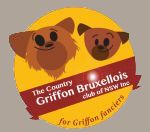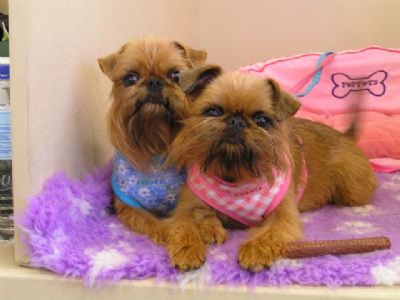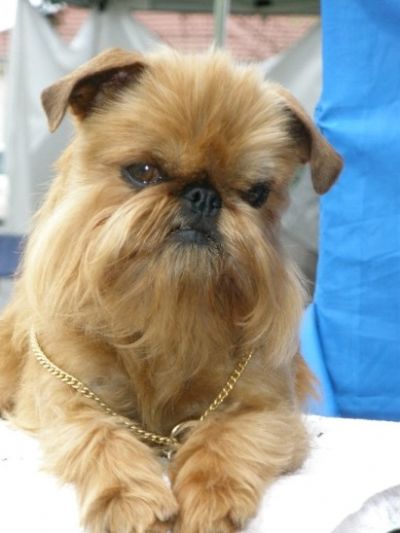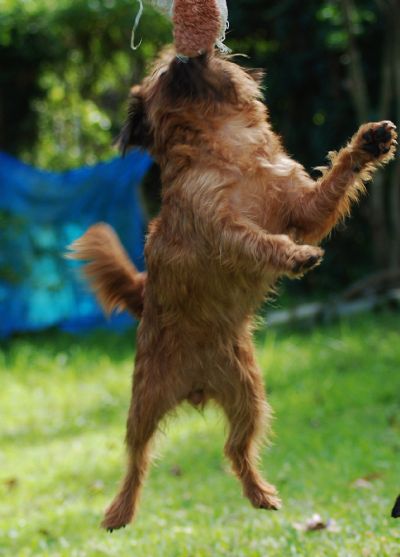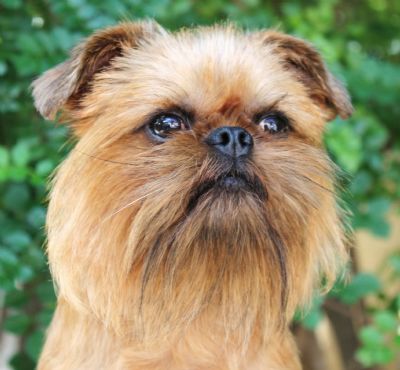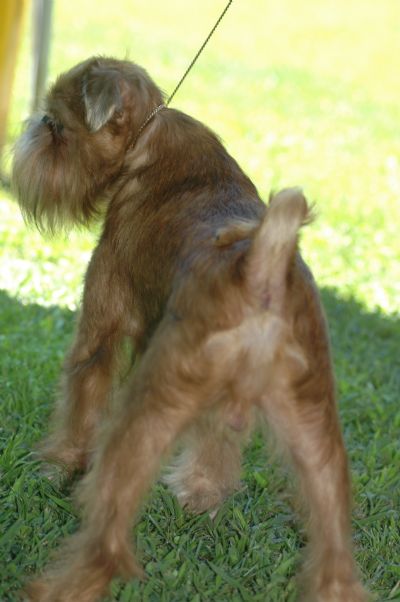The Breed Standard
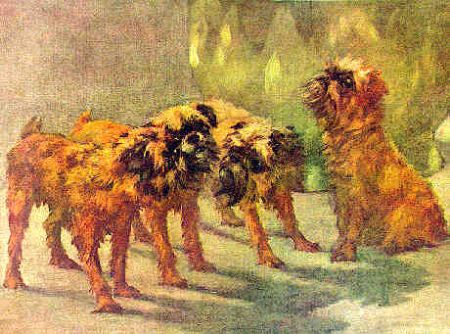
Breed Standard
|
General Appearance |
A cobby well balanced, square little dog, giving appearance of measuring the same from withers to tail root as from withers to ground |
There are 3 key words here. They are cobby, square and little.
Cobby:The standard says cobby and refers to a Cob – a solid, stocky horse that is compact, strong and sturdy- not leggy or rangy.

The Griffon therefore should be stocky and sturdy, heavy for its size and compact and balanced in appearance.
Little: The Griffon is not a large dog. Although it does not have a height standard it does have a weight standard which is 3.2 – 5 kg. A correct well balanced Griffon that is cobby, heavy for its size , sturdy, stocky and within the weight standard will not be a large dog. Griffons that are too large will lose their Toy characteristics and become coarse and heavy. It is worth while to know that the earlier standard described the Griffon as “a ladies little dog,…”
Square: The Griffon should look like a square dog when its overall body proportions are assessed. The standard states that it is “the same from withers to tail root as from withers to ground”. However this may mean a dog that looks longer than it is tall. Most breed enthusiasts prefer the Griffon to be square from the point of shoulder to the tail root.
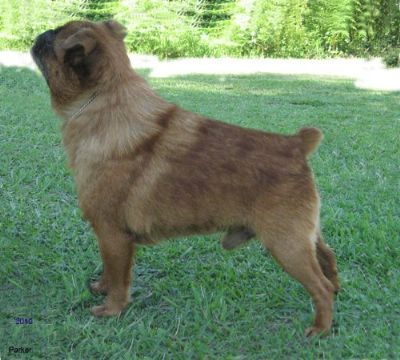
These Griffons show the correct square, cobby, body shape required by the breed standard . 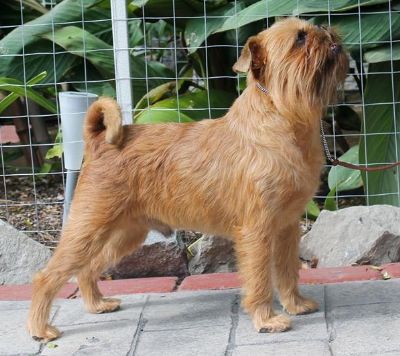
The smooth dog on the left is an 8 year old dog showing a fully mature body with well sprung ribs, a square compact body, deep chest with only a little tuck up. His weight is 4.9 kg giving the impression of a small size but heavy for his size
The red rough dog is a 3 year old, showing a mature body with well sprung ribs and a square body. He may body even more in the next 12 months as Griffons are a very slow maturing breed. His weight is 5 kg
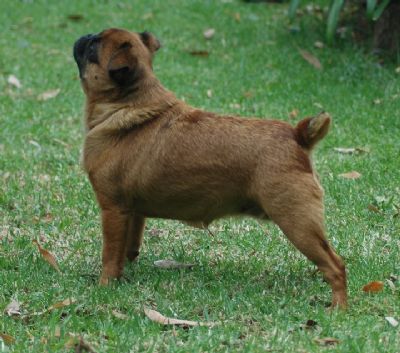
This red smooth bitch is 5 years old and again shows the square, cobby body required by the breed standard. Her weight is 4.1 kg
Note that none of these dogs are rangey or leggy. They have a medium length of neck and only a slight tuck in the underline which gives the cobby sturdy appearance.
| Characteristics :Smart little dog with disposition of a terrier. Two varieties rough coated, Griffon Bruxellois and smooth coated, Petit Brabancon. Both with pert, monkey-like expression, heavy for size |
| The early breed standards asked for a quasi –human expression. This was changed later to monkey like expression. The Griffons forward facing eyes and the rounded face and head give an almost human or monkey like expression. The intense gaze of a Griffon combined with the Griffon head tilt when it is concentrating, makes the monkey like aspect even more noticable.
The standard asks for the disposition of a terrier. This does not mean that a Griffon is aggressive or fiery like some terrier breeds. It will not spar and it does not have that rock hard temperament of some terriers.
Griffons have been companion dogs for several centuries so they can be sensitive and should not be treated harshly. The reference to a terrier like temperament means that the Griffon is sparky, bouncy, cheeky. It is a dog with confidence and a look at me attitude. Some Griffons may even give a little bark at others as they gait around the ring. They are loveable and full of good humour.
Because they were used as little guard or alert dogs on the fiacres they are very alert and interested in everything around them.
The Griffon comes in two coats the rough Griffon Bruxellois and the smooth Petit Brabancon. Under the coat they are the same dog and the 2 coats will appear in the one litter. The rough coat will be harsh to touch and is stripped. The smooth will have a satiny feel.. When judging it is important to look under the coat and be aware that good groomers can hide a multitude of faults under a carefully stripped out coat. In the smooths it is impossible to hide anything |
|
Temperament |
Lively and alert |
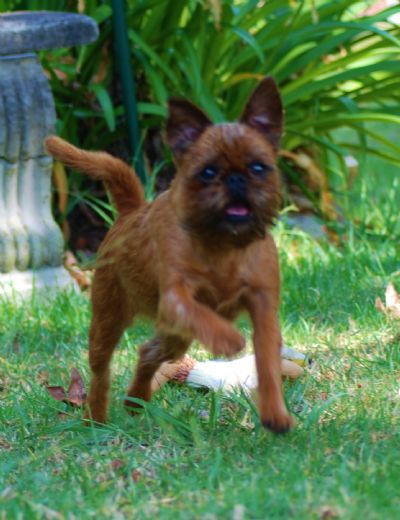
|
Head And Skull: |
Head fairly large in comparison to body, rounded but in no way domed, moderately wide between the ears. Hair on skull in roughs rather coarse. Nose always black, with large, open nostrils and definite stop between muzzle and skull. Relatively short, wide muzzle, neat lips, with good turn-up. Chin prominent, in roughs furnished with a beard. |
The head is large for the body and a Griffon has been described as a circle on a square; the head being the circle and the body being the square. It is rounded but never domed. It must have width between the ears and if it is domed then the width will be lost and the head narrows. A bitch's head may not be as large as a dogs head. The nose is always black and the nostrils should be large and open to accommodate breathing. The stop is short and very definite. When looking at an adult head the nose will almost be between the eyes. In profile the nose will have lay back and there should almost be a line down from the forehead to the chin when observing the profile. It should be possible to place a thumb into the stop behind the layback
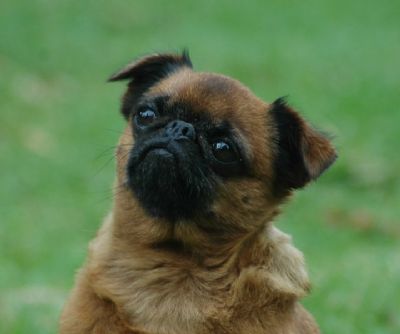
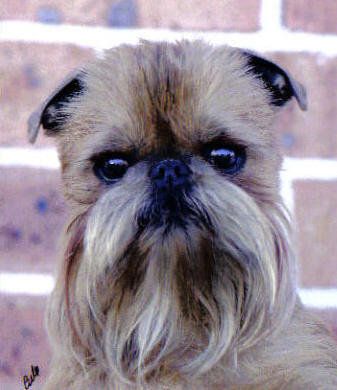
These Griffons show the correct rounded head with width between the ears and the correct ear set and eye shape and size. The smooth is a bitch and the rough a male
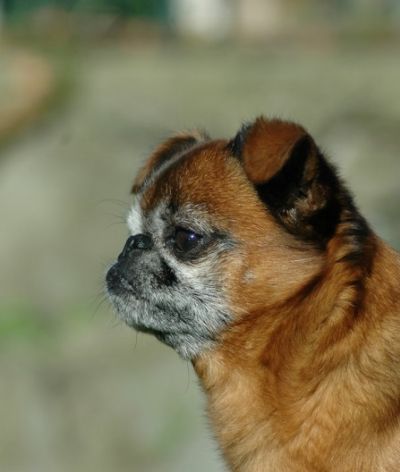
The Muzzle is short and wide with a good turn up showing a prominent chin. In roughs the chin is covered in a beard
It is important to be aware that the Griffon is a very slow maturing breed and the head will not finish growing until 3 – 4 years of age. As the head grows it will broaden across the skull, the nose will go up higher to a final placement almost between the eyes. Equally as the skull broadens the ears will look smaller.
In puppies the head will look smaller and the nose will seem to be lower.
Also in puppies the turn up will not be as obvious. This needs to be taken into consideration when judging
A correct profile of a Griffon showing the lay back of the nose and the line from the forehead to the chin. Also showing the correct turn up and prominent chin
Occasionally a puppy will show teeth a little while teething. This is not a concern as long as the mouth is not wry or twisted.
In young Griffons, especially the
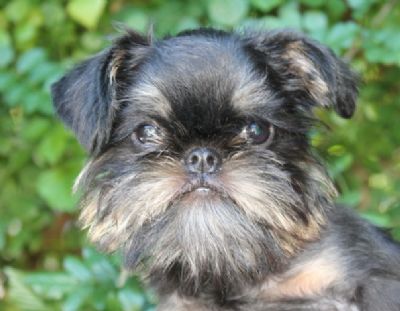
smooths, the nose will
sometimes seem to protrude more than it should and the ears will often appear to be large ears on a small pin head. This is normal. When judging the important thing is to ensure that the placement is correct.This is a good head of a 4 month old Griffon. Note the large open nostrils. The nose placement will go up higher as the pup matures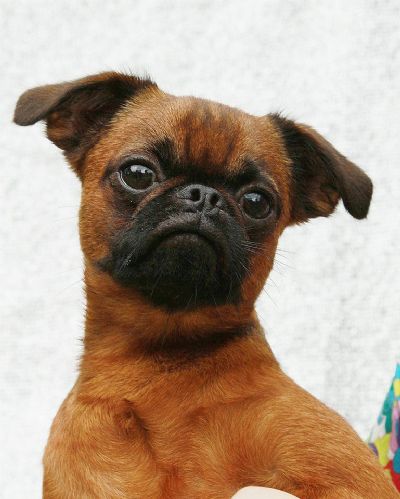
|
Eyes: |
Black rimmed, very dark, round, clear, alert and not too large. |
Eyes should be as dark as possible and round. They are forward facing. They should be alert and clear. They should be large but not so excessively large as to cause health problems. They should not bulge. The eyes on all of the dogs shown above are correct.
|
Ears: |
Semi-erect, high set, the smaller the better. |
The ears should be as small as possible, set high on each side of the broad skull. They are semi erect so the best ears will have lift and a forward fold over the top (button ears).Ears which fold a little to the side are also acceptable and should not be penalised.
The important thing is that the ears are should be as small as possible and correctly set with lift from the skull. Ears that are low set, pendulous or heavy are not correct.
The ear leather should never be below the level of the eyes. 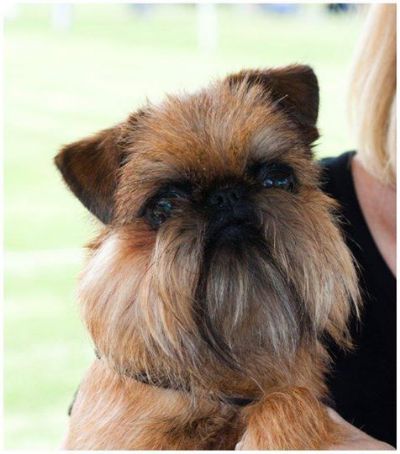

This rough and smooth Griffon display small natural ears that are set high and have a correct lift and fold – semi erect
This Griffon displays correct small high set ears with good lift and placement that fold slightly to the side
|
Mouth: |
Slightly undershot with even teeth, not showing teeth or tongue. |
.
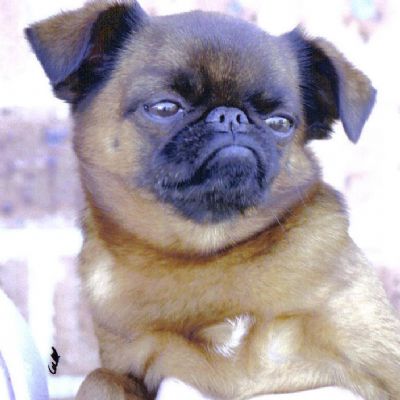
Young smooth Griffon showing good turn up and width of lower jaw
As in any brachycephalic breed the mouth does not need to be opened. When judging you should look at the face front on and check that the septum is straight. You also look at the width of the lower jaw and the amount of turn up.
This type of examination will show you if the mouth is wry or if the tongue is protruding. If need be you can also feel the lips gently with your fingers as you support the head.
It is important to know that when teething, baby Griffons have very sore mouths (they seem to be more painful than other breeds) so between the ages of 4 – 10 months they must be judged very gently as a bad experience can scar them for life
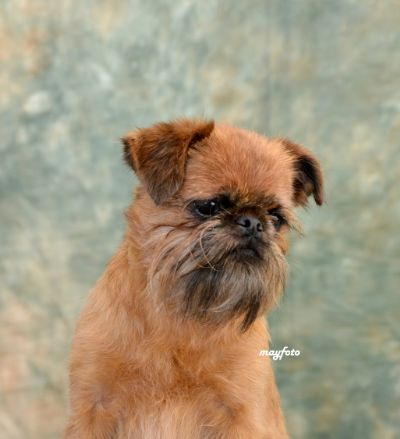
.
Rough Griffon showing correct turnup and width of jaw
|
Neck: |
Medium length, slightly arched, springing from well laid back shoulders. |
The Griffon as a medium length neck. It should not be long or Giraffe like, nor should it be short and stuffy.
The dog is a cobby, sturdy dog and the neck must be in keeping with the overall balance of the dog.
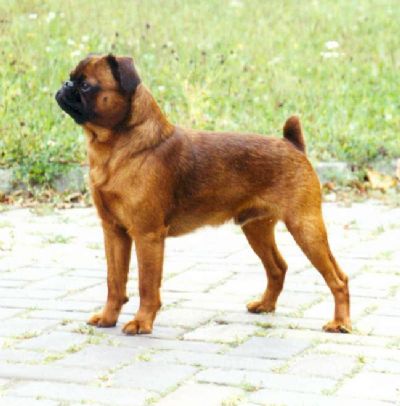
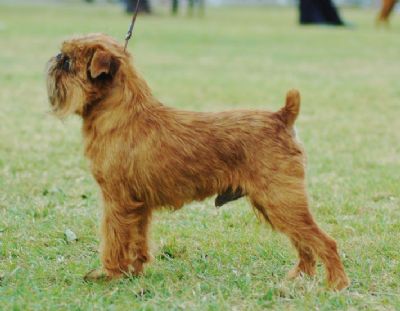
The correct neck will have a slight arch appearing almost crested and will flow in to well laid shoulders
A Griffon with a long neck will generally be rangy and lack cobbiness.
These 2 photos show correct length of neck and musculation. They also show the slight arch and the neck flowing into well laid shoulders Both these dogs have a medium length neck. A Griffon should not have a long elegant neck. A longneck is usually associated with a leggy dog with a rangy body
|
Forequarters: |
Chest rather wide and deep, legs straight of medium length and bone. |
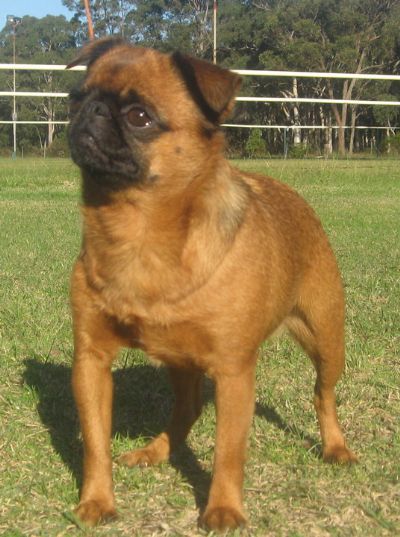
A mature Griffon will be wide and deep in the chest, usually close to a hand width
A mature Griffon bitch showing good width and depth of the chest
It is important to realise that the Griffon is a very slow maturing dog and the ribs do not fully spring or the chest drop until the dog is 3 – 4 years of age.
Usually in a growing Griffon the front will start to broaden when the dog is about 2 – 2 ½ years of age and then the chest will drop. Young Griffons should not be penalised for lacking in this depth and width as a young dog that is very broad will usually end up heavy and coarse as an adult.
The legs, when viewed from the front should be straight. Bone should be medium with enough substance to support the cobby body. Bone should not be too fine as to be spindly or too heavy as to appear coarse.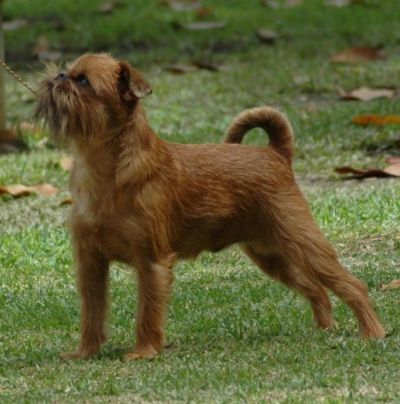
These 2 photos show the same Griffon. The photo on the top shows the dog at 12 months of age. The photo on the bottom  shows him at 2 ½ years of age. It can be seen how the chest has dropped and broadened as the dog has matured. This dog has still not finished maturing and will continue for at least another 12 months. Note the straight legs in the photos
shows him at 2 ½ years of age. It can be seen how the chest has dropped and broadened as the dog has matured. This dog has still not finished maturing and will continue for at least another 12 months. Note the straight legs in the photos
|
Body: |
Short back, level from withers to tail root, neither roaching nor dipping; deep; well-sprung ribs; short, strong loin |
The back is short, strong and level. The neck will flow into well laid shoulders and the top line will be level from the shoulders to the tail. The loins are short and strong.
The ribs are well sprung. They are oval ribs 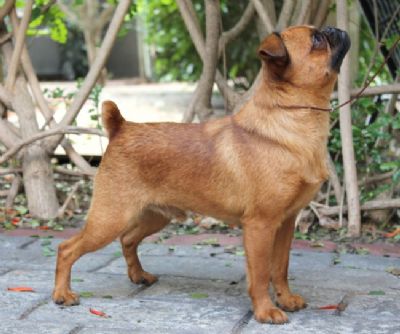 but as the Griffon matures the depth and spring of ribs will increase. The spring of the ribs, the shortness of the loin and the body contribute to the cobby appearance
but as the Griffon matures the depth and spring of ribs will increase. The spring of the ribs, the shortness of the loin and the body contribute to the cobby appearance
Young Griffon (15 mths) showing correct level top line and short back
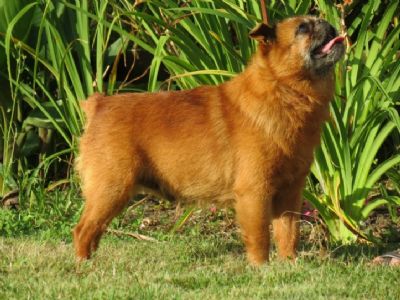
Mature Griffon (11 years) showing correct short back and level top line and well sprung ribs
|
Hindquarters: |
Well muscled thighs of good length, hocks low to ground, turning neither in nor out, stifles well bent. |
Thighs are muscular and well bent with short hocks,. When viewed from the rear the legs are straight.
The hind angulation should be balanced with the front angulation. 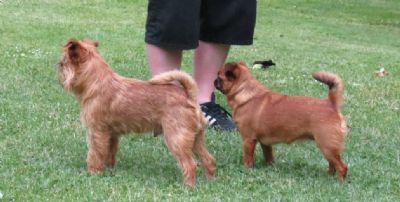
A young rough (14mths) and smooth (9mths) Griffon showing correct hind angulation when standing naturally and unposed
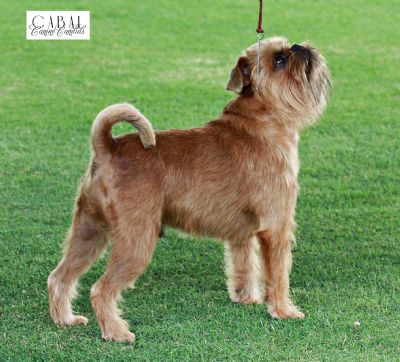
Correct hindquarters on a mature rough dog
When viewed from behind the legs should be straight with the hock not turning in or out
|
Feet:. |
Small, thick, cat-like with black toenails. |
Feet are cat like, compact and small. The pads appear thick. Toenails should be black. They are straight, turning neither in or out
|
Tail: |
Set high and carried high, left a natural length to curve gently over back when moving. Docked: Docked short, high set, emerging at right angles from the level topline. |

The tail is set high on a fairly flat croup and is carried high – standing directly up from the back in a right angle from the level top line.
It is now generally undocked but sometimes imports or occasionally a natural bob tail will be shown.
If undocked it is short and carried at a right angle
Correct tail set and carriage on a docked Griffon 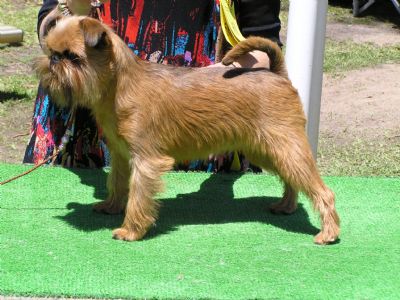
If it is undocked it should also rise at a right angle from the level top line. Ideally it should be carried high or with a slight curve over the back. However, as the breed was docked for a long period of time, tails can still appear that curl a little more than expected. As long as the tail set and top line are correct this should not be penalised unduly
Correct tail set and carriage in an undocked dog. Although the tailcurls over the back this is acceptable as the top line is level and the tail is carried up at a right angle before curling
|
Gait/Movement: |
Free with good drive from rear. Moving true coming and going. High stepping front movement undesirable |
The Griffon has well balanced angulation and should move with reach and drive. As a short bodied cobby dog it will not have an extra-long reach that may been seen in a gundog, for example, but it should still display good reach in front and drive and propulsion from behind.
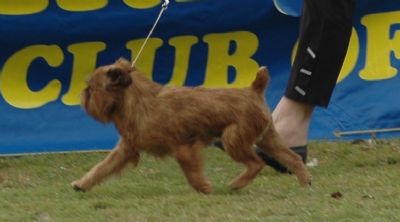
A long bodied Griffon may move with greater extension than a correct short bodied dog because they have more length in which to extend.
The gait should be straight coming and going, elbows should not turn in or out and hocks should be straight. The Griffon should maintain a level top when on the move
These photos all show correct gait on Griffons of different ages
Mature dog showing each and drive
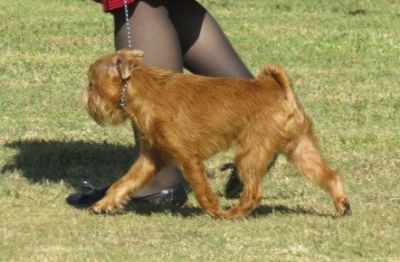
Mature rough dog showing balanced action without quite the extension of the dog above but still correct gait and holding a level top line on the move
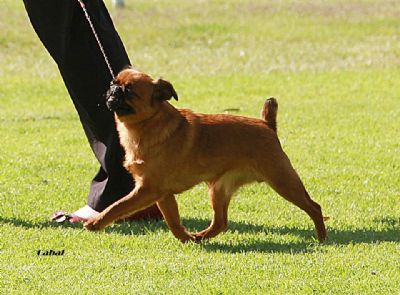
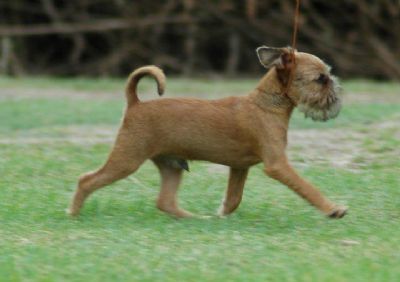
12month old smooth bitch showing correct reach and drive with good extension and correct topline
4mth old puppy showing good reach and drive and a level top line despite the young age
|
Coat: |
Roughs, harsh, wiry, free from curl, preferably with undercoat. Smooths, short and tight. |
There are two coats - the rough (Griffon Bruxellois) and the smooth (Petit Brabancon). 
The rough coat is harsh and wiry to touch but not as harsh as some of the terrier breeds. It has a double coat – a softer undercoat and a hard topcoat which is stripped for the show ring. The body is stripped to a tight jacket and the top of the head the head and the ears are also stripped fairly short, The beard is left untouched and the legs are shaped but left with slightly longer hair. Generally the harder the coat, the shorter the beard, Griffons with softer undercoats tend to have longer beards
Rough Griffon -Griffon Bruxellois
When judging it is important to feel below the coat as a skilful groomer can make a small head look wider, hide a low set tail or build up an uneven top line.
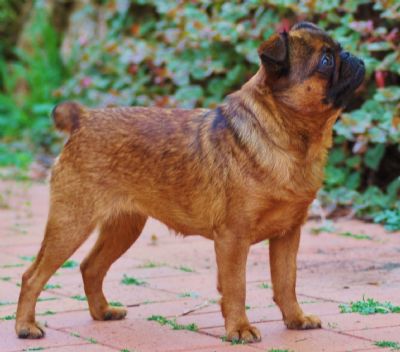
|
Colour: |
Clear red, black or black and rich tan without white markings. In clear red, a darker shade on mask and ears desirable. Ideally each hair should be an even red from tip to root. Frosting on muzzles of mature smooths should not be penalised . |
The smooths have a short, tight coat that is satiny to feel. There is little trimming done to smooths apart from basic tidying.
Smooth Griffon -Petit Brabancon
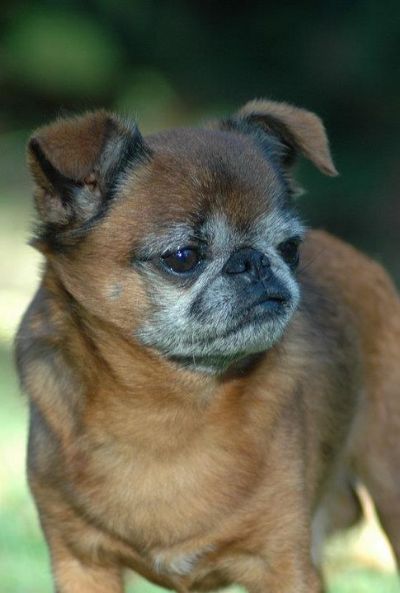
- Red – clear and solid. Dark mask desirable. The red colour can be any shade from a dark red to a wheaten red. The two dogs seen above are both red
- Black – clear and solid
- Black and Tan- black body and head. Tan on eyebrows, beard legs to hock & pastern, chest. The size, colour and placement of tan markings may vary from dog to dog but as the breed standard does not explicitly specify placement then the dog should not be penalised as long as it is clearly a black and tan
- White is not desirable on any of the colours
- Mature smooths may have frosting without penalty
Under the FCI and American standards a colour known as belge or melange is also permitted. This is red with black hairs through it – either in a pattern or all over the body
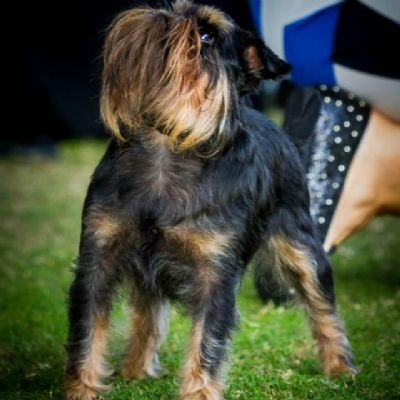
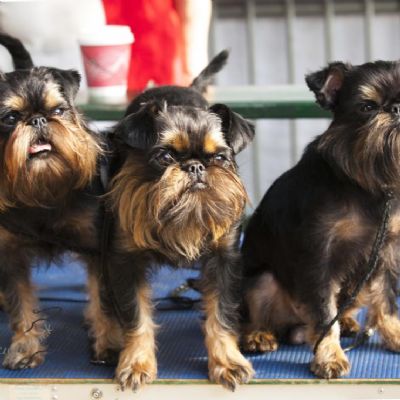
Dilute colours sometimes also appear. These include liver, liver and tan and blue and tan. There are no health issues connected with the liver dilute but there are a number of health concerns connected with the blue dilute.
|
Size: |
Weight: from 3.2-5kgs (7-11 lbs) most desirable 3.6-4.5kgs (8-10lbs) |
The general description of the Griffon specifies it as a little dog that is heavy for its sizeThe modern day Griffons are the heaviest the breed has been and in 1904 the usual weight was 5lbs- smaller than our current lowest weight. The weight range of 3.2 – 5 kg allows for a reasonably wide variation in size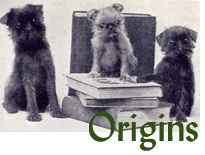
Small Griffons from the beginning of the C20th
Although there is no height standard it is important to realise that a Griffon of even 5kg that is cobby and heavy for its size will not be a large dog. While size is not the only consideration it is important to keep in mind and if deciding between 2 dogs of equal quality then the one within the breed standard should take the placement over the larger Griffon.
Griffons that are too large lose their Toy characteristics and become coarse and untypical. A Griffon is a small dog even in the Toy ring and should not approach a Miniature Schnauzer in size.
The dogs show at the top of the page to demonstrate cobbiness all weigh between 4kg and 5kg
Some confusion has arisen about size because the FCI standard has a different weight requirement and asks for dogs up to 6 kg. The breed is also in the Toy and Companion dogs group, not just Toys as in the rest of the world. This has led to a different style of Griffon that is larger, coarser and heavier, often with more leg and less cobby proportions.
It is important to also realise that a Griffon will get heavier as it matures and ages so a young Griffon even up to 3 years of age will not necessarily have the final body weight of its maturity.
Contact Details
Secretary: Marousa Polias - [email protected]
